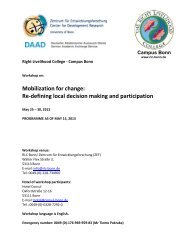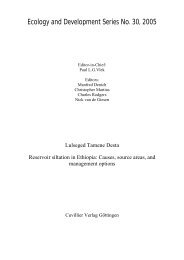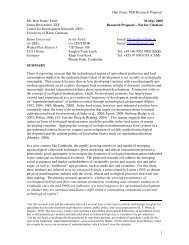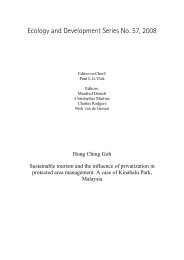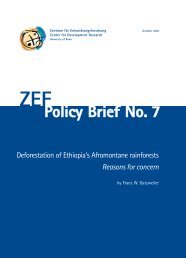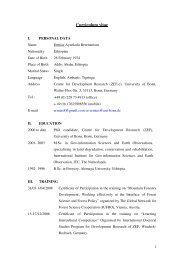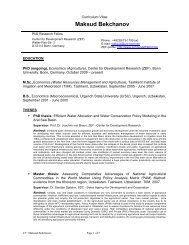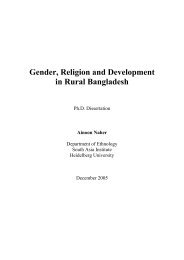Karuna Trust, Karnataka - ZEF
Karuna Trust, Karnataka - ZEF
Karuna Trust, Karnataka - ZEF
Create successful ePaper yourself
Turn your PDF publications into a flip-book with our unique Google optimized e-Paper software.
Good and Bad Practices in Microinsurance<strong>Karuna</strong> <strong>Trust</strong>, Indiaand a budget of Rs. 120,000 ($2,727) for the first year, initiated the “Information, Educationand Counselling” (IEC) component. This was a broad marketing and information campaign.Information was provided about the concept of insurance, the benefits covered, and thepremium structure (total premium and amounts subsidised for different groups). A broadvariety of information tools were used. The most important tool was <strong>Karuna</strong>’s infrastructureitself, i.e., the social workers at the Panchayat level and those at health facilities. Even today,they are the main source of information between the insurance scheme and the clients.Briefing notes for the staff have been developed (Annex 5). Additionally, a multipurposeeducation vehicle equipped with video facilities disseminates information. This van, fundedas part of <strong>Karuna</strong>’s other activities, visits villages in <strong>Karuna</strong>’s project area regularly and it isa heartily welcomed visitor. Information was also provided through newspapers, TV and incinema advertisements.The insurance scheme also made use of the public structures in place. <strong>Karuna</strong> briefed GramPanchayat officials and asked them to distribute information as part of their contribution tolocal development. In addition, the staff at the hospitals informed patients about the schemeand referred them to <strong>Karuna</strong> <strong>Trust</strong>’s contact persons.When the first clients enrolled, they received printed pamphlets with detailed information oninsurance. These were distributed on a relatively large scale. Additionally, billboards invarious locations were also used. These marketing mechanisms have not been used during therecent enrolment periods when all clients had to pay the full premium amount for the firsttime. Although marketing tools were needed the most, the lack of funds restrictedinformation dissemination to verbal communications from <strong>Karuna</strong>’s staff.In its Endline Evaluation Report, CPD evaluated the effectiveness of the informationchannels used. The main sources of information on benefits were billboards. The <strong>Karuna</strong><strong>Trust</strong> personnel and pamphlets have also been significant source of information for thehouseholds in T. Narsipur taluk. The <strong>Karuna</strong> <strong>Trust</strong> personnel supported the distribution of thepamphlets. Other health personnel, TV and newspapers have also been recognised asimportant sources of information. Although a good number of the households were wellinformed about benefits, many households still did not purchase insurance. The main reasonsgiven for this was still lack of information, lack of time to enrol, being away from the villageand not knowing whom to approach.Households felt that additional sources of information could be useful. To improveknowledge about benefits, households wish to have additional information through publicannouncements, Gram Sabha meetings 17 and discussions as well as street plays.The marketing role of SHGs is significant. In T. Narsipur taluk, about half of thepolicyholders were members of a self-help group.17 The local authority (Gram Panchayat) needs to organize a Gram Sabha meeting every six months. Allvillagers are invited to attend to hear about ongoing activities and public social schemes. The villagers arerequested to define the beneficiaries of the social schemes in these meetings i.35



